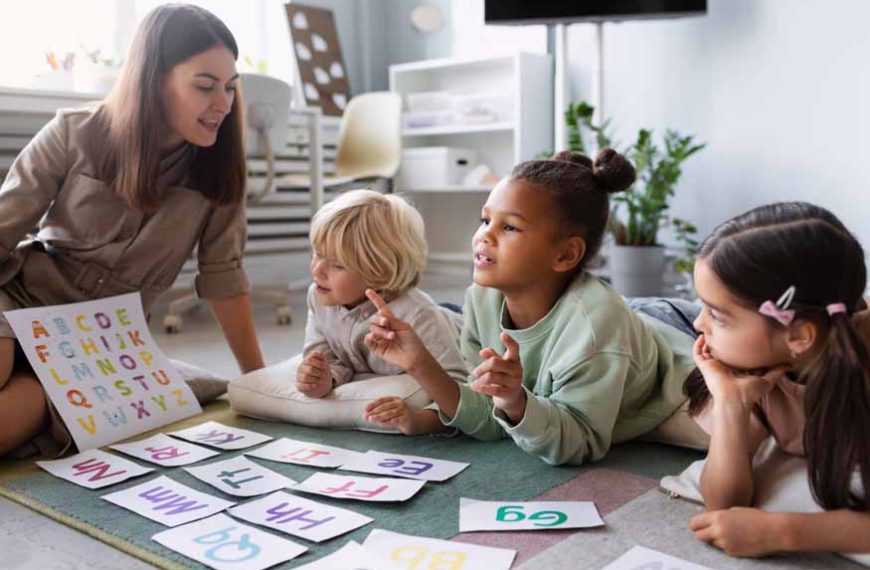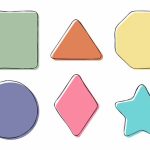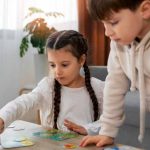A child’s early years are the most formative stage of learning. The teaching strategies used in early childhood lay the foundation for future academic, emotional, and social development. Whether you are a preschool teacher, kindergarten educator, or childcare professional, applying the right preschool teaching methods is essential for engaging children and supporting their growth.
Here are the most effective methods of teaching for preschool and pre-primary classes that foster meaningful learning experiences.
7 Major Preschool Teaching Approaches Practised Worldwide
Preschool teaching methods differ from one preschool to another depending on the approach and philosophies they follow. Let’s look at a few modern preschool teaching methods.
- Montessori
- Origin
- Philosophy
- Teaching method
- Reggio Emilia
- Origin
- Philosophy
- Teaching Methods
- Waldorf
- Origin
- Philosophy
- Teaching Method
- Playway
- Origin
- Philosophy
- Teaching Method
- Bank Street
- Origin
- Philosophy
- Teaching Method
- High Scope
- Origin
- Philosophy
- Teaching Method
- Parent Coops
- Origin
- Philosophy
- Teaching Method
- Religious Schools
- Inclusive Schools
- STEM-Based Schools
- Gifted Preschools
- Research
- Visit the Preschool Centre
- Conduct Interviews
- Parent Involvement
- Curriculum
- Teaching Methods
“Do not tell them how to do it. Show them how to do it and do not say a word. If you tell them, they will watch your lips move. If you show them, they will want to do it themselves.” Montessori is one of the most commonly practised teaching methods for nursery class.
Maria Montessori
Maria Montessori developed this preschool teaching approach in the 1900s as an Italian physician and educator.
The Montessori method emphasises individualised instruction and self-paced learning and is based on the belief that children are naturally curious and capable of learning independently.
It is a child-directed approach, and the teachers gently guide, assess the child’s needs and carefully prepare the classroom with corners or centres with specialised equipment or material that the child can work on for extended periods at their own pace. Children of various ages are grouped.
Reggio Emilia’s teaching is one of the empathetic teaching methods for nursery class that helped several students.
The Reggio Emilia is an Italian preschool teaching method coined by Loris Malaguzzi post World War II, who believed that youngsters needed a more comprehensive education.
It is founded on the idea that “a hundred languages of children,” recognises how kids can communicate their feelings and opinions. Its philosophy is that a child’s personality begins developing right from the younger years while growing and learning. We must recognise that children have numerous ways of expressing themselves and their ideas.
In this type of nursery school, the teaching method is child-led. It allows the child to participate actively in what should be taught instead of just receiving random instructions. It focuses on education through exploration and discovery with the active involvement of teachers, families, and the community to work together to make schools a rich learning environment. It encourages children to present their ideas and learn in numerous forms like painting, art and craft, drama, dance, music, and puppetry.
The Waldorf or Steiner preschool teaching method was set in motion by Austrian-born Rudolf Steiner in the early 20th century in Germany. This holistic approach to education involves students using hands-on methods and sensory-based learning.
The Waldorf preschool curriculum combines structure and creative learning. Its philosophy aims to mould well-rounded individuals who are independent thinkers. Classrooms are mixed with a play-based approach to learning.
The preschool teaching strategy encourages the child’s creative development by telling stories, creating art from available materials, taking walks and doing fun activities. There are no formal assessments, tests, homework, or grading; rather, there is a continuous testing process through various activities.
Also Read – Traditional teaching methods
The PlayWay method of preschool teaching was popularised by Fredrich Froebel (17821852), a German educator who coined the term “Kindergarten”, meaning ‘Children’s Garden’ or ‘Garden of Children’. He is also the creator of play-based preschool teaching methods and strategies.
This Nursery teaching method recognises that children love to play and use play as a driving force. The entire learning method revolves around activity-based learning. It encourages expression and creative skills among children.
This type of playgroup or nursery teaching approach is widely used in India. It relies heavily on structured and unstructured activities, including free play, role-play, art and craft activities, music and movement, and much more. Through innovative teaching and using play as a tool, various concepts are taught to the children, including numbers, colours, and even the alphabet. There is no formal assessment, and the children are not pressured to perform.
A visionary educator, Lucy Sprague Mitchell developed this nursery school teaching method in 1916 in New York City. It is influenced by John Dewey’s theory that children” learn by doing,” which focuses on not only what children learn but also how they learn. It is one of the practical preschool teaching methods and strategies.
The Bank Street approach, also known as the Development Interaction Approach, emphasises the child’s emotional, social, physical, and intellectual education using an experience-based, interdisciplinary, and collaborative setting. The aim is to make children lifelong learners.
Bank Street’s creative approach to Preschool teaching and learning recognizes that learning occurs most effectively when subjects, concepts, and individuals are actively engaged. The classroom environment isn’t competitive; teachers encourage children to learn at their own pace and through interaction with their peers. As in the play way method, playing is one of the main elements teachers use to foster learning. Instead of memorising information, children are given other ways to learn through play, the contrast being in the type of games the children play. In the Bank Street approach, children are given puzzles, clay, and blocks, and even taken on field trips to develop their logical and imaginative skills.
David Weikart and some colleagues designed the Perry Preschool Program (Now called the Highscope approach) in the 1960s to help disadvantaged preschool children develop the skills needed to succeed in the regular school system. Further, High Scope is one of the skill-based teaching methods for preschoolers.
This preschool teaching program emphasises understanding critical concepts needed for academic success in reading and mathematics. The parents are responsible for nurturing each child at their current developmental stage and assisting them in advancing it.
The teaching method in these nursery classes uses learning ‘centres’, which include building, dramatic play, maths, reading, music, writing, art, science, and motor development. The activities are both child-initiated and adult-guided. The environment is planned in such a way as to allow children to manipulate and explore the materials and then reflect later and demonstrate what they have learned in the process. Instead of seeing themselves as managers or supervisors, the adults who work with the kids see themselves more as partners or facilitators.
Do you know about this interesting fact about Parent Co-ops?
The first cooperative, formed in 1916 by twelve University of Chicago faculty wives who wanted to provide social education for their kids, parent education for themselves, and some spare time to volunteer for the Red Cross, founded the first nursery school in the United States. Parent co-ops are one teaching method in preschool that focuses on social skills.
The Co-op type preschool teaching is run with parent volunteers and teachers. Parents serve as helping hands in the classroom, making and serving food, cleaning, and doing administrative work. It is a cooperative preschool where parents work closely with the classroom teachers. With a high amount of voluntary work, the program’s and school’s operational costs are reduced, making it more affordable.
The teaching methods for this type of nursery school are unique, with the parents actively involved in choosing the teacher. They help with lessons and even observe classroom behaviour. It is an excellent way for parents to be hands-on and actively involved in their child’s education. Parent commitment and responsibilities are very high in these types of schools.
4 Distinct Kinds Of Preschool Teaching For Kids
While the above 7 types of schools are the most popular worldwide, here are a few more preschools with a slightly different focus.
Also referred to as faith-based schools, they typically cater to children belonging to a particular faith and are usually run by various religious organisations. The playgroup teaching methods, curriculum, and activities usually centre around that faith but may only partially focus on developing the child’s spiritual beliefs. However, they can incorporate religious values and stories into their lessons and may talk about God and religion without restraint.
In an inclusive preschool setting, children with special needs or developmental delays learn along with children who follow the typical development pattern. This type of schooling not only brings about awareness and understanding but also sensitises the typically developing children to those with special needs. Preschool teaching methods have also proven beneficial to children with special needs, as there is acceptance, and everyone learns to work and play together.
STEM stands for Science, Technology, Engineering and Mathematics, and the curriculum of these schools is based on these topics. The teaching methods for these nursery classes differ; rather than memorising facts and concepts, the students are given ample opportunities to research, explore, problem solve, experiment, make observations and come up with their conclusions. The teaching methods of STEM-based Schools approach are designed to create independent thinkers.
The teaching methods for these types of nursery schools are devised with the needs of individual children in mind. The children who attend these types of schools are typically much ahead of others in their age group. The parents and teachers of these children feel that they may fare better in an accelerated or more intense programme which may be a grade or two higher than their current one.
Did you know that gifted preschools encourage some of the smartest students in the world?
Apart from these, various countries have adopted and adapted many more preschool teaching methods specific to their needs. Many may even choose to follow a hybrid approach, which is a mashup of two or more approaches to preschool teaching and learning. We have chosen, highlighted and explained the most popular ones, some of which are available in India.
Choosing the right preschool or nursery with the right teaching methods for your little one should be carefully considered. Research and exploration are the keys. After all, no one knows your child or your circumstances better than you.
6 Important Factors To Select The Best Preschool Teaching Techniques For Your Child
These are a few pointers to help you choose a playgroup, nursery, or preschool teaching method that best suits you.
While we have provided a glimpse into different preschool teaching methods used in nursery schools, read up further on those that have caught your attention.
This will give you an idea of the proximity to your home. You can also use this opportunity to look at the setup inside the school. Observe the teachers and children.
Talk to the manager, teachers and even some parents to better understand the school and clarify any doubts you may have.
Understand the parent involvement required in the preschool of your choice to determine if you can devote the required time.
Explore, understand and talk about the nursery curriculum, and how it is handled. Also, the ease the child will transition into another form of education should you decide to change schools when they are older.
Finally, discuss and observe the nursery teaching methods used to see if they match your child’s learning style and if you are comfortable with them.
When scouting for preschools, check out one of the popular EuroKids preschool centres near you. The curriculum offered is child-friendly and keeps in mind the holistic development of your little one, with teachers who are continuously trained to care for the needs and inspire young students in the classroom.
Conclusion
In this article, we have learned about the innovative preschool techniques that are used globally to teach children. The article also explains the seven major preschool teaching methods in detail. We also elaborate about the four distinct kinds of preschool teaching in case you are interested in enrolling your little one there as per your individual needs.
Being a leading brand in early childhood services our curriculum at EuroKids is designed by an experienced team that incorporates art and craft, hands on learning and experiential exercises to tap into a young student’s energy and creativity, all within a structured school schedule and an environment that promotes learning.
For informative and accurate articles on all things related to your newborn to toddler’s development, growth, health and nutrition, follow EuroKids Blogs and do check out our nationally recognised preschools – EuroKids for the first step in your kid’s educational journey!















